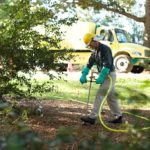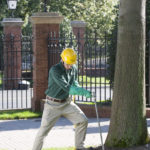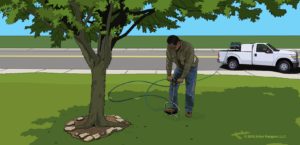It all starts with providing some supplemental nutrition for small to medium-aged trees in the late fall when trees go into a state of dormancy. This is when trees stop active growth and begin to form terminal buds, drop leaves and develop cold resistance. Adding fertilizer to trees too early in the season can push new growth which will be prone to winter damage.
A fertilization program is used to maintain trees in a vigorous condition and to improve their immune system against pests. Fertilizing trees refers to the practice of adding supplemental nutrients (chemical elements) required for normal growth and development. However, you really can’t “feed” a tree, since trees are autotrophs. They use nutrients to feed themselves by making sugar in the leaves through photosynthesis.
Nitrogen (N), phosphorus (P), and potassium (K) are plant nutrients needed in the largest quantity and these are most commonly applied as a complete fertilizer. However, the addition of any soil nutrient is recommended only if soil or plant foliage tests indicate a deficiency. For trees and shrubs in most of Indiana, the two most common causes of nutrient problems are high pH (alkaline) soils, which can lead to chronic deficiencies of nutrients in some tree species, such as red maple and pin oak, and nitrogen-deficient soils. Typical symptoms include yellowing chlorotic leaves and reduced growth and smaller leaf size.
Trees in natural settings get nutrients from the air, organic matter, nutrient cycling, and microbial activity. In many cases, supplemental nutrition is not necessary in fertile soils which have enough nutrients in the proper amounts to support healthy growth, especially on established trees, but in the urban and suburban environment, often a little assistance is needed. The more challenging urban environment provides less opportunity for healthy growth due to poor, fragmented soils, reduced microbial activity and compaction. Trees needing fertilization to stimulate growth include those exhibiting the symptoms of pale green, undersized leaves, chlorosis, reduced growth rates and those in decline resulting from insect attacks or disease problems. Also, turf can be a serious contender for nutrients and trees surround by turf benefit from additional nitrogen applications every couple of years.
Trees which should not be fertilized include newly planted trees in the current year and those with root damage from recent trenching, construction or other disturbance. The root systems of these plants will need to re-establish before fertilizers are applied with cultural practices such as supplemental moisture and mulch. Older, established trees do not need to be fertilized every year and may never need supplemental feeding. In fact, serious pest problems can result on over-fertilized trees. Research indicates that young deciduous trees benefit from additional nitrogen in low-analysis, slow release forms. Conifers require less fertilization and are genetically adapted to low-nutrient soils.
For more information on how and when to fertilize trees, refer to HO-140-W, Fertilizing Woody Plants from the Purdue Extension Education Store.



